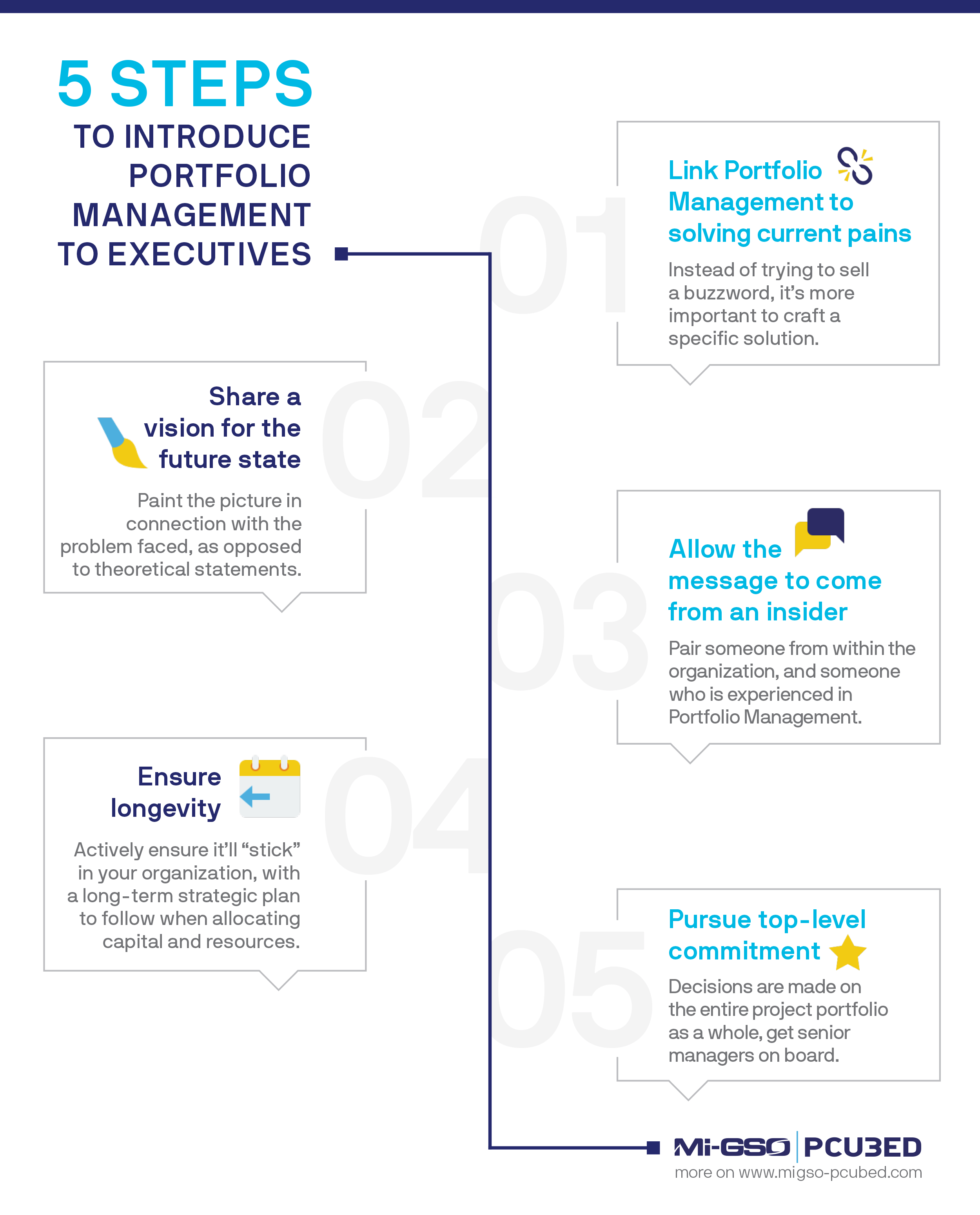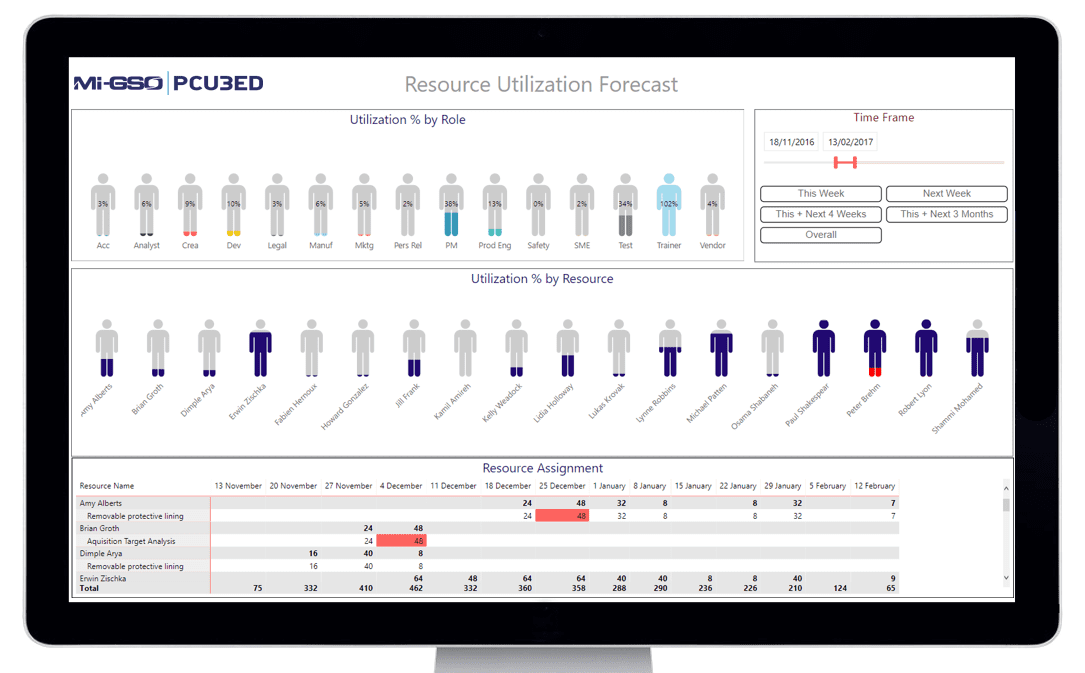Our website is not supported on this browser
The browser you are using (Internet Explorer) cannot display our content.
Please come back on a more recent browser to have the best experience possible

Introducing Project Portfolio Management (for short portfolio management) to senior management typically generates resistance. After all, putting a methodology in place to prioritize and manage projects requires humans to change how they work, and that’s never easy. Factors such as industry, state of the market, culture, and personalities vary so much that coming up with one approach for introducing portfolio management is bound to fall flat.
Although it’s no silver bullet, the practice of project portfolio management (PPM) can help organizations today to more efficiently respond to market shifts and new innovations.
Portfolio Management is the disciplined approach to overseeing the overall collection of projects and programs in which the organization has invested. The goal of PPM is to make sure that resources are invested in initiatives that support the strategic objectives of the organization as they evolve.
Institutions that employ PPM as a practice stand out because they apply methods to the sometimes-haphazard decision-making that goes on in determining what projects warrant an investment.
Timing is a tricky matter when selling any idea and interest in portfolio management seems to be very cyclical in nature. However, over the past 20 years, MIGSO-PCUBED has found five steps that can help sell the idea of portfolio management to your executives, by improving the initial perceptions of what portfolio management is and thus increasing the likelihood of its subsequent adoption.

The first thing to do is to get the attention of people who can make portfolio management a reality in the business. Since senior managers barely have time for their scheduled meetings, you need to immediately resonate with some of their current problems. A great start would be linking the introduction of portfolio management to one of their current pains.
The most common example is the strategic planning cycle. Many organizations have moved to more frequent and agile planning cycles. As such senior executives need the ability to react and then quickly adapt for both new and major initiatives and budget reduction activities.
Second, we hear a lot of clients talk about resource management. They say things like, “We need to better manage our resources or budgets”, “We need to realize efficiencies” or, “We don’t know who is actually working for us. We may know their names, but we don’t know what projects they’re supporting.”
The sensible way to act in such circumstances is not to promote portfolio management, but to initially solve the immediate problem. For example, create the transparency the client wants in order to provide that overview of resource allocation.

Read more on Effective Resource Demand Management
Once that’s done, and the client’s trust is gained, you can tackle some of the underlying, more fundamental problems; such as people working on too many of the wrong projects or projects that don’t contribute to strategic objectives. Instead of trying to sell a buzzword, it’s more important to craft a specific solution for the client.
Once the current problem is established, the next step is to paint the picture where the challenge will be solved. Usually, this picture includes an efficient and controlled way to deal with planning or re-planning efforts.
Some of the tangible benefits include:
The expected benefits should be presented in connection with the problem faced by the organization, as opposed to theoretical statements.
From a logistical perspective, the team introducing portfolio management to a senior leader must inspire trust and expertise. Therefore, the best dynamic for this team is to bring in both someone from within the organization, who is trusted by the executive team, and additionally someone who is experienced in portfolio management. This latter person could be either internal or external.
These two individuals need to work well together. Expertise without trust is usually perceived as just another sales meeting, and trust without expertise is always perceived as incompetence.
Once participants are sold on the idea of portfolio management, you need to actively ensure it’ll “stick” in an organization. That requires a long-term strategic plan to follow when allocating capital and resources. The strategic plan usually includes the major goals of the organization over a number of years (typically, three to five). And it’s endorsed by all the key people who are ultimately responsible for executing it.
A problem common to large organizations is a “silo” mentality that grows up in different business units or functional areas. Each silo has its own perspective on what the crucial strategic objectives are. Therefore, a strategic plan can measure how a specific project portfolio achieves one or more of its long-term objectives. Additionally, it serves as an objective way of quantifying performance and progress for the organization and the senior executives.
Portfolio management’s main feature is to align project investments to the organization’s strategy and continually reassess projects against changing conditions. This is why it’s appropriate to call it a top-down management approach. Decisions are made on the entire project portfolio as a whole, rather than on an individual project basis.
As such, for portfolio management to succeed, a vital element is support from the top of the organization – senior managers. You need to bring those senior managers on board and get them committed to succeed in the portfolio management implementation.
The process we have just outlined really works. A group of internal clients was pitching a particular executive on the idea of portfolio management. They presented a great overview, focusing on all the common benefits that could be delivered with the efficient allocation of resources.
The executive challenged everything, declaring that enough resources were available to fund every as long as each had a good case. So, he couldn’t see the point in going through such an exercise. After meeting with his staff, his big problem was a lack of transparency in what was going on. He was sorting a lot of daily operations as project work. Once the discussion zeroed in on transparency, it clicked for him, and he opened up to portfolio management and its benefits.
Want to know how Project Portfolio Management (PPM) is changing for 2020? Our global team of experts shared the top 4 trends that are shaking up PPM.
In summary, the road to integrating portfolio management will be long and difficult. You’ll need to ensure that the organization follows through with your plans if they truly are the right fit. However, when everything is said and done, the realized benefits will be the satisfying marker of a job well done.
This article was written by Eric Shalayko
Loved what you just read?
Let's stay in touch.
No spam, only great things to read in our newsletter.
We combine our expertise with a fine knowledge of the industry to deliver high-value project management services.
MIGSO-PCUBED is part of the ALTEN group.
Find us around the world
Australia – Canada – France – Germany – Italy – Mexico – The Netherlands – Portugal – Romania – South East Asia – Spain – Switzerland – United Kingdom – United States
© 2024 MIGSO-PCUBED. All rights reserved | Legal information | Privacy Policy | Cookie Settings | Intranet
Perfect jobs also result from great environments : the team, its culture and energy.
So tell us more about you : who you are, your project, your ambitions,
and let’s find your next step together.
Dear candidates, please note that you will only be contacted via email from the following domain: migso-pcubed.com. Please remain vigilant and ensure that you interact exclusively with our official websites. The MIGSO-PCUBED Team
Choose your language
Our website is not supported on this browser
The browser you are using (Internet Explorer) cannot display our content.
Please come back on a more recent browser to have the best experience possible
